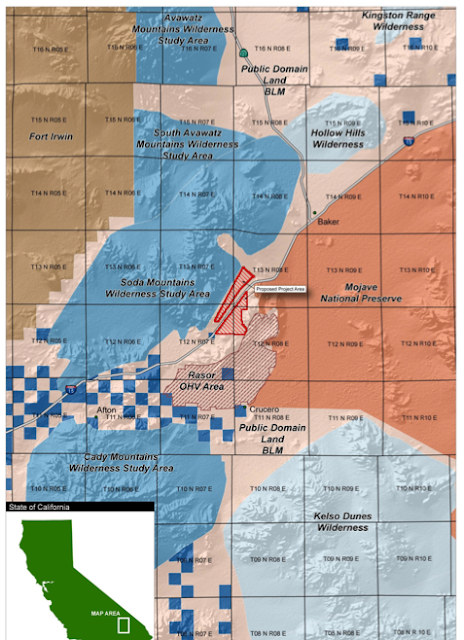Caithness Solar Threatens Heart of the Mojave Desert
A project proposed by New York-based Caithness Energy could degrade or destroy up to 6.8 square miles of public land identified by the Nature Conservancy study as "biologically core" to the health of the Mojave Desert. The Soda Mountain Solar Project would be built on pristine desert habitat--mostly creosote scrub--and would likely disrupt an essential habitat connectivity corridor.
Basin and Range Watch, the special status plant survey carried out for the plan of development was only cursory in nature and conducted in December when the extent of botanical resources are less apparent. The plan of development also reports finding no desert tortoises on the project site, despite the relatively intact tortoise habitat. Previous surveys for other proposed solar project have grossly underestimated the presence of tortoises.
The BLM probably should conduct a more thorough plant and wildlife survey before supporting industrialization of this habitat, since the project could block wildlife migration corridor linking the central Mojave with areas to the west, according to a review of the Nature Conservancy's Mojave Deser Ecoregional Assessment. It's possible the BLM has already clued in on the dangers of this particular proposal, since the land record available for the application notes that the Soda Mountain solar project has been "de-prioritized" due to unspecified conflicts.
More information, photos of the area, and a link to the BLM plan of development is available at the Basin and Range Watch website.
Basin and Range Watch, the special status plant survey carried out for the plan of development was only cursory in nature and conducted in December when the extent of botanical resources are less apparent. The plan of development also reports finding no desert tortoises on the project site, despite the relatively intact tortoise habitat. Previous surveys for other proposed solar project have grossly underestimated the presence of tortoises.
The BLM probably should conduct a more thorough plant and wildlife survey before supporting industrialization of this habitat, since the project could block wildlife migration corridor linking the central Mojave with areas to the west, according to a review of the Nature Conservancy's Mojave Deser Ecoregional Assessment. It's possible the BLM has already clued in on the dangers of this particular proposal, since the land record available for the application notes that the Soda Mountain solar project has been "de-prioritized" due to unspecified conflicts.
More information, photos of the area, and a link to the BLM plan of development is available at the Basin and Range Watch website.




Comments
Post a Comment